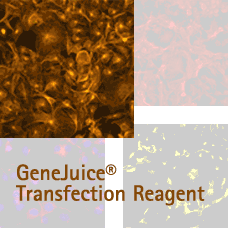70967 Sigma-AldrichGeneJuice® Transfection Reagent
Non-lipid based chemical transfection reagent optimized for maximum transfection efficiency, ease-of-use, and minimal cytotoxicity on a wide variety of mammallian cells.
More>> Non-lipid based chemical transfection reagent optimized for maximum transfection efficiency, ease-of-use, and minimal cytotoxicity on a wide variety of mammallian cells. Less<<Productos recomendados
Descripción
| Replacement Information |
|---|
Precios y disponibilidad
| Número de referencia | Disponiblidad | Embalaje | Cant./Env. | Precio | Cantidad | |
|---|---|---|---|---|---|---|
| 70967-3 |
|
Frasco de vidrio | 1 ml |
|
— | |
| 70967-4 |
|
Frasco de vidrio | 10 ml |
|
— |
| Description | |||||
|---|---|---|---|---|---|
| Overview | ""I use GeneJuice because it's ease-of-use, low toxicity and wide range of target cells"" Stuart Rulten. Research Fellow. University of Sussex ""Since we have been working with GeneJuice, we have saved a lot of time and money!"" Dr. Andrea Kress, Institute of Clinical and Molecular Virology, Erlangen, Germany ""I find that Genejuice works for a multitude of cell types with minimal optimization"" Caitriona Marie Lyons. PhD Student. University College Cork, Ireland Transfection Overview and Reagents Transfection is the process by which nucleic acids are introduced into mammalian cells. GeneJuice Transfection Reagent is a proprietary formulation optimized for maximal transfection efficiency, ease of use, and minimal cytotoxicity for mammalian cells. Whereas many available transfection reagents are based on cationic lipid formulation, GeneJuice Transfection Reagent is composed of a nontoxic cellular protein and a small amount of a novel polyamine. GeneJuice Transfection Reagent enables highly efficient DNA transfer in both stable and transient transfections of eukaryotic cells and is ideal for high-throughput transfections in a multi-well plate format. The unique composition is compatible with both serum-containing and serum-free media, making media changes unnecessary during transfection experiments. Genejuice is a superior alternative to a wide variety of other techniques including calcium phosphate coprecipitation, electroporation, microinjection, biolistic particle delivery, lipofection, and complex formation with DEAE-dextran. The 1 ml size provides enough reagent to perform up to 500 transfections in standard 35 mm plates. |
||||
| Cell Lines: | Primary Cells: | ||||
|---|---|---|---|---|---|
|
10T1/2 293T 3T3 NIH 3T3 Swiss 3T3-L1 A204 A431 A549 alpha TC1-6 AR 42J As4.1 AtT-20 B50 BC-1 BC-2 BC3 BCBL BHK-21 C3H/10T1/2 C6 C2C12 |
Caco-2 Caki-1 Calpan-1 Calu-1 Calu-6 CCL-131 CFPAC-1 Chang Liver CHO CHO-7 CHO-IR CHO-K1 COS-1 COS-7 CS-1 CV-1 Daudi DDTI MF-2 DT40 ECV304 EL4 |
ES-E14TG2a EVSCC17M H9c2 HCT-116 HEK293 HeLa HeLa B HeLa T4 Hep 3B2.1-7 HepG2 Hepa 1-6 Ht-29 HTB-37 HTB-45 Huh-7 HUVEC IC21 IEC-6 JEG-3 Jurkat KB |
L57-3-11 L-6 L-929 MA-10 McA-RH7777 MCF-7 MCF-10-2A MDCK Melanocyte MG-63 Neuro 2A Neuroblastoma NRK NT2/D1 OV-1063 OVCAR3 P4 P19 PC12 PA317 PAM212 |
PS-1 R2C RAW 264.7 RBL-2H3 RMP-41 SAOS-2 SC-1 Schneider line2 SK-N-MC SK-N-SH SKOV3 STO SW-480 SW-837 T3M4 TM4 U937 UCD Vero |
Aortic smooth muscle cells Astrocytes Angioblasts Chondrocytes Chromaffin cells Epithelial cells: mammary prostate tracheal Fibroblasts Keratinocytes |
- Highly efficient DNA transfer for both stable and transient transfections
- Minimal cellular toxicity
- Compatibility with both serum-containing and serum-free media
- Simple protocol—no need for media changes
- Ideal for high-throughput transfection in a multi-well plate format

| References | |
|---|---|
| References | |
| Product Information | |
|---|---|
| Declaration | GeneJuice® is a registered trademark of EMD Chemicals Inc. |
| Quality Level | MQ100 |
| Applications |
|---|
| Biological Information |
|---|
| Physicochemical Information |
|---|
| Dimensions |
|---|
| Materials Information |
|---|
| Toxicological Information |
|---|
| Safety Information according to GHS |
|---|
| Safety Information | |
|---|---|
| R Phrase | R: 11 Highly flammable. |
| S Phrase | S: 7-16 Keep container tightly closed. Keep away from sources of ignition - No Smoking. |
| Product Usage Statements |
|---|
| Packaging Information |
|---|
| Transport Information |
|---|
| Supplemental Information |
|---|
| Specifications |
|---|
| Global Trade Item Number | |
|---|---|
| Número de referencia | GTIN |
| 70967-3 | 07790788052928 |
| 70967-4 | 04055977256215 |
Documentation
GeneJuice® Transfection Reagent Ficha datos de seguridad (MSDS)
| Título |
|---|
GeneJuice® Transfection Reagent Certificados de análisis
| Cargo | Número de lote |
|---|---|
| 70967 |
Referencias bibliográficas
| Visión general referencias |
|---|
Folleto
| Cargo |
|---|
| Bulk Product Guide |
| Nano Juice™ Transfection Kit |
| The Complete Molecular Biology Toolkit - Expert workflow solutions from DNA cloning to protein expression |
| Transfection: A Science and an Art |
Citas
| Título | |
|---|---|
|
|
Protocolos de usuario
| Cargo |
|---|
| TB289 |










